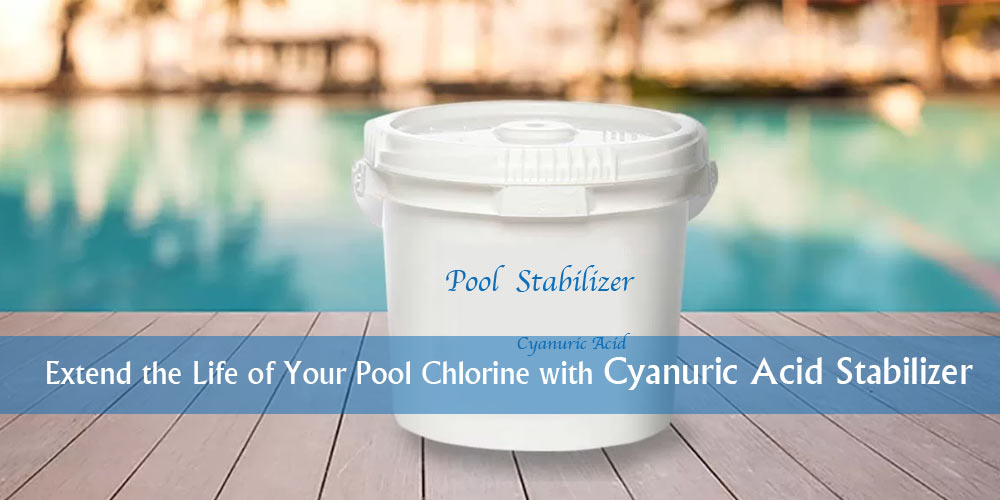Pool chlorine stabilizer — Cyanuric Acid (CYA, ICA), acts as a UV protectant for chlorine in swimming pools. It helps reduce chlorine loss due to sunlight exposure, thus improving the efficiency of pool sanitation. CYA is commonly found in granular form and is widely used in outdoor pools to maintain stable chlorine levels and reduce the need for frequent chemical additions.
How does Cyanuric Acid work?
When chlorine is added to pool water, it naturally decomposes due to exposure to the sun’s ultraviolet (UV) rays. Unprotected chlorine can lose up to 90% of its effectiveness in just a few hours in direct sunlight.
When Cyanuric Acid is added to a pool, it combines with the free chlorine in the pool to form a chemical bond. This protects the chlorine in the pool from the sun’s UV rays, extending the life of the chlorine.
In addition, Cyanuric Acid absorbs UV rays, causing the intensity of UV rays that can act on HClO to decrease. (Thus, the chlorine concentration in outdoor pools increases with water depth.)
By using CYA, pool owners can reduce chlorine losses by up to 80%, reduce the frequency of chlorine use, and reduce overall maintenance costs.
What level of Cyanuric Acid should be in my pool?
The level of Cyanuric Acid in a pool should be between 20-100ppm. As a rule of thumb, it is best to test the stabilizing agent (CYA) every 1-2 weeks to maintain the correct level.
Cyanuric Acid concentrations greater than 80ppm will cause chlorine lock, which is characterized by decreased chlorine disinfection, algae growth at high chlorine concentrations and without chlorine odor. The only way to resolve chlorine lock is to drain the pool and add new water, the amount of water drained will depend on the current Cyanuric Acid concentration in the pool. It is very difficult to completely remove Cyanuric Acid from the pool because it can become trapped in the filter.
Cyanuric Acid Dosage Calculation
To determine the correct amount of Cyanuric Acid to add to your pool, use the following general guideline:
To increase CYA by 10 ppm, add 0.12 kg (120 g) of Cyanuric Acid granules per 10,000 liters of water.
How to Use Cyanuric Acid in Your Pool
Step 1: Test Your Pool’s CYA Levels
Before adding Cyanuric Acid, test your pool water with a CYA test kit. The CYA level for most outdoor pools is 20-100 ppm (parts per million). Levels above 100 ppm may cause chlorine lock, and the chlorine becomes less effective.
Step 2: Add Cyanuric Acid Properly
Cyanuric Acid can be added in two forms:
Cyanuric Acid Granules: Add directly to the pool following the manufacturer’s instructions.
Stabilized Chlorine Products (such as Tri-Chlor or Di-Chlor): These products contain built-in stabilizers that gradually increase CYA levels over time.
Step 3: Monitor and Adjust as Needed
Test your pool’s CYA level regularly to ensure it remains within the optimal range. If levels are too high, diluting with fresh water is the only effective way to reduce CYA concentrations.
Cyanuric Acid is an essential chemical in your outdoor pool. Not only does it extend the life of the pool’s effective chlorine, it also protects the pool’s chlorine from damaging UV rays from the sun. And the use of pool chlorine stabilizers minimizes maintenance work. Pool operators do not need to add chlorine frequently, thus reducing labor and maintenance time.
If you have an outdoor pool, you can choose to use a pool disinfectant containing Cyanuric Acid. Such as: sodium dichloroisocyanurate, trichloroisoCyanuric Acid. If the pool disinfectant chooses calcium hypochlorite, you must use it with Cyanuric Acid. In this way, your pool disinfection effect can last. And from a long-term perspective, the use of Cyanuric Acid in outdoor pools is a more economical choice.
If you have any questions about the purchase or use of Cyanuric Acid. Please contact me. As a professional supplier of swimming pool chemicals, Yuncang will give you a more professional answer.
Post time: Feb-21-2025


